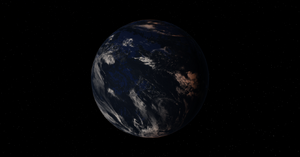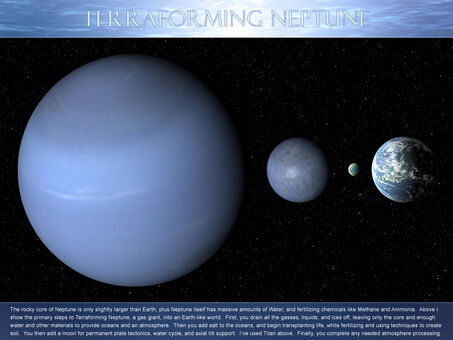Jeansowaty2 (talk | contribs) No edit summary Tag: Source edit |
No edit summary Tag: Visual edit |
||
| Line 1: | Line 1: | ||
| − | [[File:TerraformedNeptune-US2.png|thumb|300px|How a terraformed Neptune could look like, made in Universe Sandbox 2 by Jeansowaty.]]'''Neptune''' is |
+ | [[File:TerraformedNeptune-US2.png|thumb|300px|How a terraformed Neptune could look like, made in Universe Sandbox 2 by Jeansowaty.]]'''Neptune''' is a gassy ice giant (stinky :/ ). This would make it difficult to terraform, but not impossible. |
==Changing the atmosphere== |
==Changing the atmosphere== |
||
Revision as of 14:53, 14 October 2021

How a terraformed Neptune could look like, made in Universe Sandbox 2 by Jeansowaty.
Neptune is a gassy ice giant (stinky :/ ). This would make it difficult to terraform, but not impossible.
Changing the atmosphere
Neptune has a rich abundance of hydrogen and helium in its atmosphere. Underneath this is a rocky core with a mass of 1.2 Earth masses. Terraforming Neptune would be extremely difficult, requiring most of the atmosphere to be removed. Once the core is left, it would be given a new atmosphere using the oxygen from the water collected, nitrogen from the ammonia, and carbon dioxide using carbon from methane. A heat source would need to be added to sustain habitable temperatures. Since Neptune's magnetic field would be weakened once the water-ammonia layer is gone, some extra protection may be needed (like an ozone layer). The Neptunian core is slightly larger than Earth, so it would have enough gravity to hold onto an atmosphere.
Creating more moons

Terraformed Neptune (far right) with Titan as a moon to restart the dynamo.
And that would only be the first step. As the atmospheric layers are slowly removed, (and potentially used for fusion with any excess hydrogen and helium added to Saturn or Jupiter), Neptune's mantle of methane, ammonia and water would be collected and stored. This layer is between 10 and 15 Earths in mass, the bulk of which could be used to create multiple moons around Neptune, each one more massive than Earth and with oceans that could support life. The orbits of the moons would need to be close to each other and Neptune to take advantage of the increased heat from tidal forces.